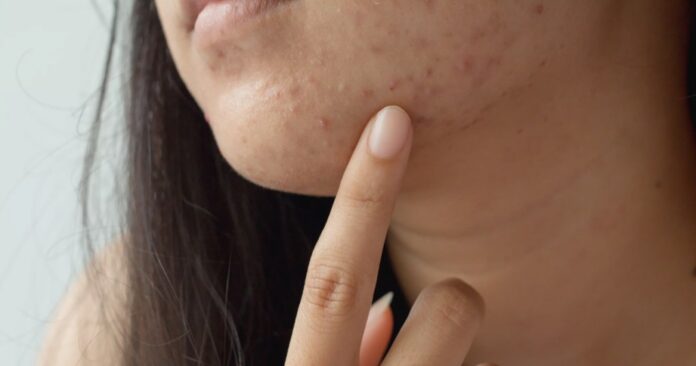Introduction
It’s no new thing to see hair on mature men’s faces, back, neck, and legs. It is a common characteristic among males who have reached puberty. Some men who have reached puberty and don’t have this feature sometimes grow them artificially. In men, hair growth is caused by the influence of sex hormones called androgens
1
. This hormone is produced in large amounts in men.
Conversely, it is usually not good when a woman grows hair in male patterns. And although this is quite rare, many women grow hair just like men. This can be embarrassing for these women and usually occurs due to imbalances related explicitly to excess androgens in their bloodstream.
Although men growing hair is natural and makes them look more manly, it can be excessive. And yes, you guessed right, the overproduction of the androgen hormone causes this.
However, before we get to the specifics, excessive hair growth in men and women anywhere on the body and the growth of hair androgen-dependent sites in women are different medical conditions. The former is termed Hypertrichosis
2
, and the latter is hirsutism
3
.
While both medical conditions result in excess hair growth on a person’s body, there are crucial differences between them. In this article, we explore both Hirsutism and Hypertrichosis in more detail, discuss the causes, types, and treatments, and everything you should know about these two medical conditions.
Let’s get right to it!
Definitions of Hirsutism and Hypertrichosis
Hirsutism
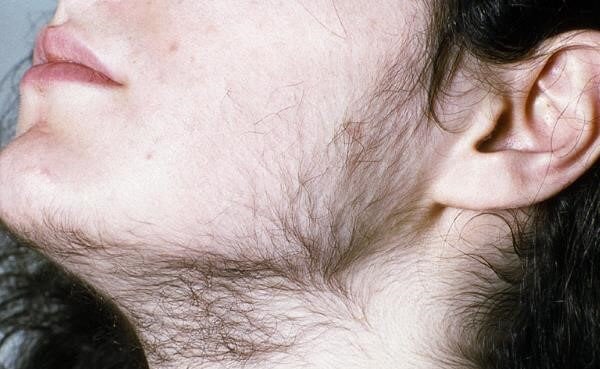
In simple terms, hirsutism is a common condition in which women grow coarse hair in areas where male hair usually grows. Ordinarily, women should not grow hair in some areas of the body, such as the chin, but when women start growing hair in these areas, it signifies an imbalance in hormone regulation of such women
3
.
Maintaining levels of androgens is crucial for women’s health, albeit in quantities compared to men. However, an excessive amount of these hormones can manifest masculine features like the hair pattern observed in hirsutism. Often hirsutism indicates a condition that triggers the production of androgens, including testosterone. This condition has different causes, some of which we will consider shortly.
Hypertrichosis
However, hypertrichosis is extreme hair growth in both men and women, although it is most common in men. This condition, although rare, is relatively easy to notice. Men with hypertrichosis have extreme hair growth on their foreheads, cheekbones, and other body parts that hair doesn’t typically grow
2
. This condition is also called werewolf syndrome and is far rarer than hirsutism
4
.
Also, it can manifest excessively in common hairy areas of the body, such as the legs, chest, etc. The hair in hypertrichosis differs from regular hair as it tends to be finer and lighter in color. Hypertrichosis is a condition that can either be present since birth (congenital) or linked to factors like eating disorders or certain medications.
Like hirsutism, hypertrichosis is caused by extreme production of androgen hormones, precisely testosterone. However, there are other causes of hypertrichosis. Now let’s talk about the different causes of these two conditions, starting with Hirsutism.
Causes of Hirsutism
There are many known causes of Hirsutism. Below are some of the most common ones.
1. Polycystic Ovarian Syndrome
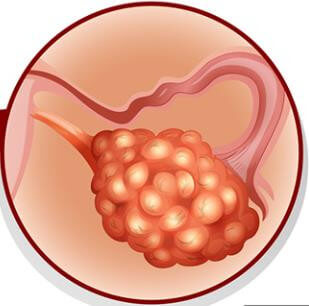
Polycystic ovarian syndrome, also known as PCOS, is when the ovaries produce excessive androgens, especially the male sex hormones, usually in women in small amounts
5
.
PCOS is one of the most commonly known causes of Hirsutism in women. 70 – 80% of women with PCOS experience hirsutism
6
. In this condition, there’s an imbalance in the regulation of the androgen hormones in the body, especially male testosterone, resulting in the precipitation of some male features such as hair growth. Other symptoms of PCOS include irregular periods, difficulties conceiving, acne, weight gain, anxiety, and depression.
2. Side-Effects of Medication
Another common cause of hirsutism is the side effects of some medications. Different types of medication can cause Hirsutism as a side effect
3
. Examples of these medications include anabolic steroids, Prozac, and Danazol. To learn more, click here.
3. Cushing’s Syndrome

Cushing’s Syndrome usually occurs when a person’s body is overexposed to the cortisol hormone
7
. The adrenal glands in the body could be responsible for producing too much cortisol, or it might also develop by taking certain medications, such as prednisone, over an extended period. This high exposure to cortisol may stimulate the production of androgen hormones, which in turn may result in hair growth
8
.
4. Congenital Adrenal Hyperplasia
This condition is hereditary and is typically characterized by the irregular and abnormal production of androgens and cortisol, steroid hormones created by a person’s adrenal glands, resulting in excessive hair growth
9
.
5. Ovarian Tumors
Although it only accounts for about 1% of all cases, developing a tumor that secretes androgens in either the adrenal glands or the ovaries can lead to a person developing Hirsutism
10
.
Causes of Hypertrichosis?
As said earlier, hypertrichosis is a rarely diagnosed disorder that can impact a person’s entire body and significantly alter its severity from one person to the next. While it is often confused with Hirsutism, it is far rarer and will typically affect different areas of a person’s body.
Many theories have been developed over the years to explain the causes of this condition. There are also different types of hypertrichosis, and establishing the specific subcategory of the condition is essential when discussing the various causes of hypertrichosis.
1. Congenital Hypertrichosis
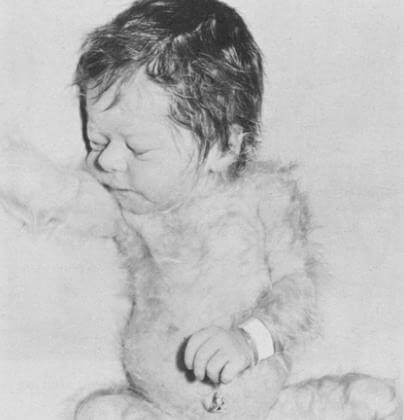
Arguably the most common cause of hypertrichosis is congenital type
11
. It is thought to run in families, and it is notoriously characterized by genes responsible for stimulating hair growth and which have become irregularly active. In almost all cases, the genes that had caused hair to grow all over a human’s body to keep them warm are no longer active, as hair is no longer needed to heat the body.
There is no known cure for people who have congenital hypertrichosis. This type of Hypertrichosis will be present from birth, and in total, there have been just a few cases known cases of this type of condition in the modern-day
11
.
2. Acquired Hypertrichosis
Acquired hypertrichosis, sometimes called prepubertal hypertrichosis, is characterized by hair growth and has been linked to levels of male sex hormones in specific individuals
12
. However, acquired hypertrichosis that develops later in life can result from different causes. These may include nutrition, an unhealthy diet, or specific eating disorders like anorexia nervosa.
Certain medical conditions like hair growth treatments, cancer, cell mutations, autoimmune disorders, or infectious diseases affecting the skin can contribute to hypertrichosis
2
. Sometimes, porphyria
cutanea tarda
can trigger hypertrichosis by making the skin highly sensitive to radiation. Moreover, hypertrichosis in localized areas of the body could be associated with skin conditions such as lichen simple –characterized by recurring rashes and persistent itching and scratching in regions.
3. Drug-induced Hypertrichosis
Medicines most often cause acquired generalized hypertrichosis
13
.
❖ Antibiotics such as streptomycin
❖ Anti-inflammatory drugs such as benoxaprofen and corticosteroids
❖ Vasodilators (diazoxide, minoxidil, prostaglandin E1)
❖ Diuretics (acetazolamide)
❖ Anticonvulsants (phenytoin)
❖ Immunosuppressants (cyclosporine, mycophenolate mofetil)
❖ Psoralens (methoxypsoralen, trimethylpsoralen)
❖ Antiseptics (hexachlorobenzene)
❖ Chelators (penicillamine)
❖ Interferon-alpha
❖ Fenoterol
❖ EGFR inhibitors (cetuximab, panitumumab, erlotinib, gefitinib)
Although medication is usually the culprit, hypertrichosis can also occur with traumatic brain injury, juvenile hypothyroidism, juvenile dermatomyositis, acromegaly, malnutrition, and late HIV infection.
There you have the three major causes of hypertrichosis. Before discussing the treatment options, here are common symptoms of hypertrichosis.
Symptoms

The indication of hypertrichosis is an excess of hair compared to what’s considered typical for an individual’s age, race, and gender. Additionally, the hair may grow in areas. It’s important to note that not all hypertrichosis hairs are identical. There are three types of hair associated with hypertrichosis;
1. Lanugo Hair
Lanugo hair, also known as delicate hair, is commonly found on the bodies of babies. This type of hair doesn’t have any color. It tends to fall out within a few weeks after birth. However, individuals with hypertrichosis might retain lanugo hair until they intentionally remove it
14
.
2. Fluffy Hair
Vellus hair, which grows on the hand, is characterized by its pigmentation. It can be present over the body except in areas that lack hair follicles, such as membranes, soles of the feet, and palms
15
.
3. Long Hair
When it comes to hair, long hair it’s typically the darkest. It has a thick and coarse texture. The growth of this type of hair is influenced by sex hormones. You usually find hairs in regions like the face, armpits, and groin area.
In women experiencing hirsutism (male pattern hair growth), long hairs often develop on the back, arms, and chest. Moreover, it’s worth noting that symptoms of hypertrichosis may vary in severity over time.
Treatment Options for Hypertrichosis
Sadly, there is no long-lasting cure for hypertrichosis. However, the risks may be reduced by avoiding the triggers, such as medications, unhealthy eating habits, etc. However, there are a few short-term solutions to hypertrichosis, some of which include:
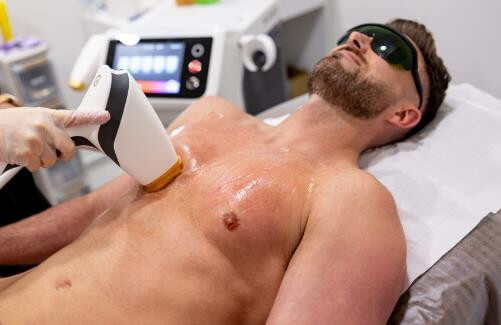
Laser hair removal is a safe technique widely used for treating hypertrichosis. By targeting and destroying hair follicles, the laser ensures that hair growth in those areas is long-lastingly halted. Interestingly laser hair removal is even considered suitable for children due to its effectiveness and safety. The treated regions for hypertrichosis include the legs, arms, and back.
In addition to laser hair removal, electrolysis is another method for treating hypertrichosis. Although less popular than laser treatment, electrolysis proves to be equally efficient. However, it’s essential to note that electrolysis can be somewhat painful and carries a risk of complications. It becomes the choice when dealing with melanin content in the hair that renders laser treatment ineffective.
Treatment Options for Hirsutism.
Although the medical treatment of hirsutism is far from being entirely successful, there are different options for the treatment of hirsutism. Let’s consider a few of those.
-
Antiandrogens
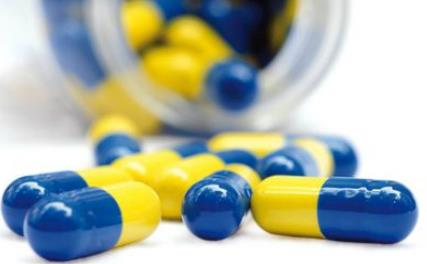
Antiandrogens are drugs that interfere with androgen action at the target organ
16
. They either block enzyme reactions, thereby limiting the formation of potent androgens, or specifically block the androgen receptor in the skin. This reduces the level of androgens in the body and reduces the risk of hirsutism. However, consult with a physician because these drugs have adverse side effects.
While on antiandrogen hormonal treatment, it is also beneficial to have hair removal procedures. This provides an immediate effect while waiting for the hormone treatment’s long-term results.
Although electrolysis is advertised as long-lasting hair removal, in many women, regrowth occurs. Combining medical therapy to remove stimulus for new hair growth with the mechanical removal of established hairs (conventional electrolysis or laser treatment) offers the best cosmetic results. In recent years laser hair removal has revolutionized the treatment of hirsutism.
Conclusion
See that! apparently, hirsutism and hypertrichosis are two different medical conditions, and we have just discussed many things you need to know about them. However, even with what we have discussed, some people may still find it a little difficult to distinguish between these two medical conditions.
Hence, if you’re experiencing hair growth, it’s advisable to consult your doctor, who can determine the root cause and discuss treatment options with you. And most importantly, before you jump on any treatment options for either of these conditions, ensure you get the green light from your physician.
References
- Miranda, B. H., Charlesworth, M. R., Tobin, D. J., Sharpe, D. T., & Randall, V. A. (2018). Androgens trigger different growth responses in genetically identical human hair follicles in organ culture that reflect their epigenetic diversity in life. FASEB journal: official publication of the Federation of American Societies for Experimental Biology, 32(2), 795–806. https://doi.org/10.1096/fj.201700260RR
- Saleh D, Yarrarapu SNS, Cook C. Hypertrichosis. [Updated 2022 Jul 4]. In: StatPearls [Internet]. Treasure Island (FL): StatPearls Publishing; 2023 Jan-. Available from: https://www.ncbi.nlm.nih.gov/books/NBK534854/
- Hafsi W, Kaur J. Hirsutism. [Updated 2023 May 3]. In: StatPearls [Internet]. Treasure Island (FL): StatPearls Publishing; 2023 Jan-. Available from:https://www.ncbi.nlm.nih.gov/books/NBK470417/
- Alam, S. T., Rahman, M. M., Akhter, S., Hossain, M. A., & Islam, K. A. (2012). Congenital hypertrichosis (Were Wolf Syndrome): a case report. Mymensingh medical journal: MMJ, 21(3), 567–569.
- Azziz R. (2018). Polycystic Ovary Syndrome. Obstetrics and Gynecology, 132(2), 321–336.https://doi.org/10.1097/AOG.0000000000002698
- Spritzer, P. M., Barone, C. R., & Oliveira, F. B. (2016). Hirsutism in Polycystic Ovary Syndrome: Pathophysiology and Management. Current pharmaceutical design, 22(36), 5603–5613.https://doi.org/10.2174/1381612822666160720151243
- NIDDK. (2023, March 8). Cushing’s Syndrome. National Institutes of Health. Retrieved fromhttps://www.niddk.nih.gov/health-information/endocrine-diseases/cushings-syndrome
- Grymowicz, M., Rudnicka, E., Podfigurna, A., Napierala, P., Smolarczyk, R., Smolarczyk, K., & Meczekalski, B. (2020). Hormonal Effects on Hair Follicles. International Journal of Molecular Sciences, 21(15).https://doi.org/10.3390/ijms21155342
- Hasan, R., Juma, H., Eid, F. A., Alaswad, H. A., Ali, W. M., & Aladraj, F. J. (2022). Effects of Hormones and Endocrine Disorders on Hair Growth. Cureus, 14(12).https://doi.org/10.7759/cureus.32726
- Spritzer, P. M., Marchesan, L. B., Santos, B. R., & Fighera, T. M. (2022). Hirsutism, Normal Androgens and Diagnosis of PCOS. Diagnostics, 12(8).https://doi.org/10.3390/diagnostics12081922
- Pavone, P., Praticò, A. D., Falsaperla, R., Ruggieri, M., Zollino, M., Corsello, G., & Neri, G. (2015). Congenital generalized hypertrichosis: The skin as a clue to complex malformation syndromes. Italian Journal of Pediatrics, 41.https://doi.org/10.1186/s13052-015-0161-3
- ScienceDirect. (2023, July 15). Hypertrichosis. ScienceDirect. Retrieved from https://www.sciencedirect.com/topics/pharmacology-toxicology-and-pharmaceutical-science/hypertrichosis
- Souza, K. F., Andrade, P. F. B. C., Cassia, F. F., & Castro, M. C. R. (2020). Cyclosporine-induced childhood generalized hypertrichosis. Anais brasileiros de dermatologia, 95(3), 402–403.https://doi.org/10.1016/j.abd.2019.08.027
- Mendiratta, V., Harjai, B., & Gupta, T. (2008). Hypertrichosis lanuginosa congenita. Pediatric dermatology, 25(4), 483–484.https://doi.org/10.1111/j.1525-1470.2008.00716.x
- Cardoso Chagas, F. S., Donati, A., Doche Soares, I. I., Valente, N. S., & Romiti, R. (2014). Trichostasis spinulosa of the scalp mimicking Alopecia Areata black dots. Anais Brasileiros de Dermatologia, 89(4), 685-687.https://doi.org/10.1590/abd1806-4841.20142407
- ScienceDirect. (2023, July 21). Antiandrogens. ScienceDirect. Retrieved from
5548

 By Nancy H, PharmD
By Nancy H, PharmD






